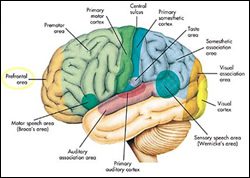Behavioral Disorders
By: Candace Hutchins
Two examples of specific behavioral disorders are attention-deficit disorder and learning disorders. Verbal learning disorders are disorders of reading, arithmetic or written expression. Children with nonverbal learning disabilities have deficits in visual-perceptual skills, tactile-perceptual and psychomotor abilities.
Dyslexia is a common learning disability that is characterized by problems with reading and writing. One of the most researched areas of neuropathology in children with dyslexia is that their left and right hemisphere planum temporales are asymmetric (Zillmer, 2008). Postmortem studies of children with learning disabilities confirm abnormalities because they have found neuronal ectopias or brain warts on the left plenum temporale. PET scans of children with dyslexia show that poor reading skills are likely due to less cerebral blood flow in areas of the temporal cortex (Zillmer, 2008).
Children with nonverbal learning disabilities have the opposite problems of children with verbal learning disabilities and therefore their brains have right hemispheric deficits. Many learning disorders are often comorbid with other disorders that children may have such as Asperger’s syndrome, autism, fetal alcohol syndrome, hydrocephalus, intracranial tumors, traumatic brain injuries, Turner’s syndrome, Williams syndrome and diabetes (Zillmer, 2008).
 The second major behavioral disorder that is usually identified around the time children begin formal education is Attention-deficit Hyperactivity disorder (ADHD). ADHD is more common in boys than girls and children show symptoms of inattention, hyperactive/impulsive or combination of both in two or more settings. Symptoms include internalization of speech, regulation of arousal, emotion, motivation and reconstitution of behavior.
The second major behavioral disorder that is usually identified around the time children begin formal education is Attention-deficit Hyperactivity disorder (ADHD). ADHD is more common in boys than girls and children show symptoms of inattention, hyperactive/impulsive or combination of both in two or more settings. Symptoms include internalization of speech, regulation of arousal, emotion, motivation and reconstitution of behavior.
Research on the brains of children with ADHD has indicated that abnormalities in the structure of the corpus callosum that disrupts the transmission of impulses between the cerebral hemisphere that is necessary for behavioral control. Behavioral inhibition is also a result of disrupted communication from the frontal lobes. Decreased cerebral blood flow and other metabolic abnormalities of the basal ganglia and subcortical nuclei below the frontal lobes causes less activation and problems with executive functioning. Research has also found structural differences in the cerebellum because of a smaller volume that may be a reason for children having hyperactive motor symptoms.

